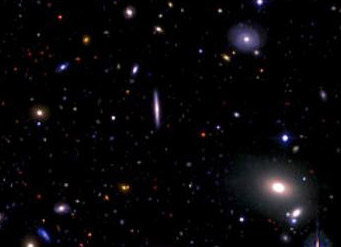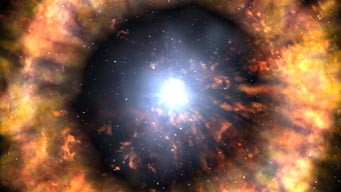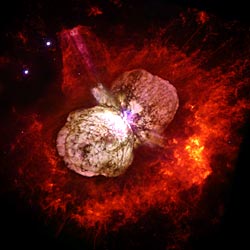When a very massive star self-destructs as a supernova, the resulting fireball is so luminous that the event can be seen across billions of light-years' distance — if you look carefully enough.
That's the take-home message from observers led by Jeff Cooke (University of California, Irvine), who've tracked down a pair of supernovae that exploded 11.0 and 11.4 billion years ago. These "lookback times" smash the previous record of about 9 billion years and correspond to when the universe was only about 20% of its present age. A third ancient supernova identified in their study, published in the July 9th edition of Nature, dates to about 8 billion years.

This image, taken with Canada-France-Hawaii Telescope as part of its Legacy Survey, shows one of the deep fields used to find the most distant supernovae to date.
Jeff Cooke / CFHT
So how'd they do it? Cooke's team utilized "stacking," a technique well known to backyard astrophotographers.
First, the observers identified very distant galaxies in survey images taken by the Canada-France-Hawaii Telescope atop Mauna Kea. Next they combined multiple images of the same star fields (to make the galaxies more evident) and then compared those "stacks" to ones made at different times.
Any change in a galaxy's brightness, particularly in a spot offset from its center, suggested that a supernova had occurred. Follow-up spectroscopy with the bigger Keck telescopes not only confirmed that some candidates were indeed supernovae but also allowed Cooke's team to calculate their redshifts (z = 2.357, 2.013, and 0.808) and, in turn, their age.

This artist’s impression shows how layers of gas are ejected by a massive star prior to its self-destruction as a supernova.
NASA / Swift / Skyworks Digital / Dana Berry
These titanic blasts are designated Type IIn supernovae, which result from very massive stars (50 to 100 Suns) that spew much of their mass into space before they explode. Once one of these unstable cores collapses and creates a supernova, the expanding shock wave slams into the previously ejected matter and creates a blaze of ultraviolet-rich light that takes months to fade. In fact, Cooke's team estimates that more than 90% of all supernovae detectable at such great distances must be of this type.
Astronomers are excited by this newfound ability to see such distant blasts. As Cooke points out in a Keck Observatory press release, studying the deaths of these early stars is essential to understanding the evolution of the early universe.
Moreover, the stacking technique should lead to the discovery of even more distant supernovae — possibly even a few of the very first stars to blow themselves apart.
And I'm guessing that these ultra-distant blasts will contribute much to the debate over the enigmatic concept of dark energy.

Eta Carinae and its surrounding Homunculus Nebula, as captured (in false color) by the Hubble Space Telescope. The mighty star ejected the hourglass-shaped Homunculus in vast outbursts observed in the 1800s. The star itself, and its possible companion, are buried deep within the central whitish dot.
Astronomers are quick to point out that a potential Type IIn supernova is lurking, menacingly, in our interstellar backyard. The star Eta Carinae, just 7,500 to 8,000 light-years away, has already belched lots of its outer layers to space.
And the star itself is unstable. An outburst in 1843 made it second in nighttime brightness only to Sirius. It dimmed to 8th magnitude and remained there for decades, only to double in brightness during 1998-99.
Needless to say, observers are keeping a close eye on this one!
 3
3
Comments
Sebastian Otero
July 8, 2009 at 10:12 pm
As a side note, it is interesting to note that right now eta Carinae is brighter than ever before after its great XIX century eruption.
My visual observation for tonight indicates that is still rising and it has become even brighter than V= 4.7.
You must be logged in to post a comment.
Peter Wilson
July 9, 2009 at 11:02 am
"And I'm guessing that these ultra-distant blasts will contribute much to the debate over the enigmatic concept of dark energy." http://www.dark-energy.org
You must be logged in to post a comment.
Peter Wilson
July 9, 2009 at 11:02 am
"And I'm guessing that these ultra-distant blasts will contribute much to the debate over the enigmatic concept of dark energy." http://www.dark-energy.org
You must be logged in to post a comment.
You must be logged in to post a comment.